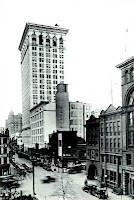 |
| The Lasting Products Company ad, circa 1946 |
Until 1937, downtown Baltimore City homes looked like many other homes within urban landscapes across America - concrete or brick-faced or even slated wood - but U.S. Patent Number 2,095,641 would change all that. Lewis Albert Knight (he went by "Albert") had a vision which eventually transformed the traditional row home-lined Baltimore City street only to become a distinctive part of its unique heritage. Mr. Knight graduated from Franklin High School in Reisterstown, studied at the Maryland Institute, and eventually received his bachelor's degree from Johns Hopkins University. He died in 1980 at the age of 76.
On March 1, 1937, this Glyndon native filed his patent as an assignor to the Lasting Products Company where he was employed at the time - "A process of making artificial stone wall facings." It was marketed to thousands of homeowners that it would "make your home the neighborhood showplace," "beautiful, long-lasting," and "maintenance free."
 |
| The FormStone Original, PlateMarker |
Simulated stone was found in other cities, and while the Formstone patent expired 17 years later, it went by a multitude of other brands such as "Perma-stone," "Dixie Stone,""Rostone," "Silverstone," TruStone,""Bermuda Stone,"Modern Stone," "Romanstone," "Magnolia Stone," "Fieldstone," or "Stone of Ages." It was the rage throughout the 40s, 50s, and 60s, given that homeowners seemed to love it as it covered up brick and other masonry imperfections, helped modernize home appearances, and was advertised to be near maintenance-free. Those who dreaded the idea of repeated, exterior wall painting, saw hope in the concept.
 |
| "Little Castles" Rowhomes in Baltimore (Photo: Courtesy, theatlanticcity.com) |
According to "Old House Journal, 1982," Formstone was not the only affront to be sprayed, rolled, poured, or smeared over original exteriors. For instance, there was the "Merit Wall Method"which was marketed by Merit Enterprises. A thick rubbery material was sprayed over everything but the window glass -- cornices, gutters, and door frames were not exempted. Suspended in goo was fine stone dust and the effect was that of a huge metalflake balloon having been stretched over the house and then cut out at the doors and windows." Fortunately, it never caught on to the extent of Formstone.
Native son and avant-garde film director, John Waters, affectionately referred to it as the "Polyester of Brick" and went so far as to document it in one entitled "Little Castles: A Formstone Phenomenon." Due to its prolific use in over 50 percent of Baltimore row homes, preservationists to this day debate over what is worthy of preservation - the pre-faux or the post-faux look. The idea of preserving Formstone in Baltimore has been creeping into the modernist mentality, while others have decided that tradition is what lies beneath. A Baltimore Sun article, December 1, 2012, states that the Baltimore City Council seems to be of the impression that it is a rather tacky appearance and needs to henceforth be banned from further proliferation and use. What opinion do you have, hon?














